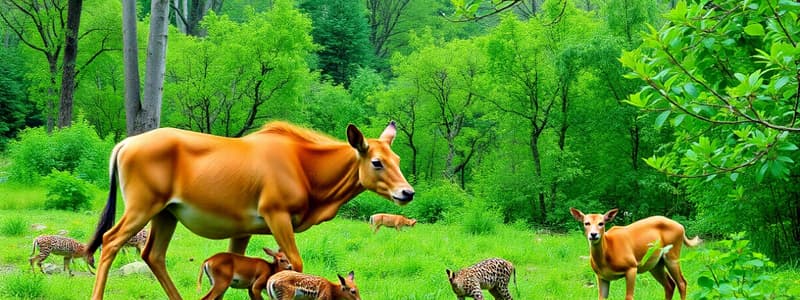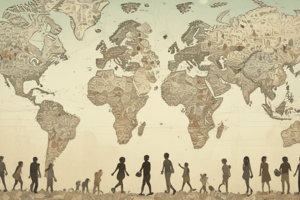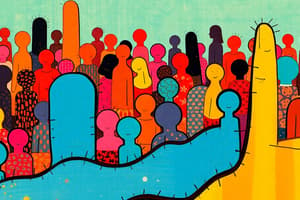Podcast
Questions and Answers
What determines population growth when there are no predators and resources are abundant?
What determines population growth when there are no predators and resources are abundant?
- The rate of reproduction and initial population size (correct)
- The environmental conditions and available space
- The migration patterns of species
- The survival rate of offspring
What does the term 'biotic potential' refer to?
What does the term 'biotic potential' refer to?
- The role of disease in limiting population size
- The impact of invasive species on ecosystems
- The potential for extinction of a species
- The capacity for rapid population growth under ideal conditions (correct)
In terms of population dynamics, what do the symbols N, r, and t represent?
In terms of population dynamics, what do the symbols N, r, and t represent?
- The natural ecosystem, rate of extinction, and total biomass
- The population size, reproductive rate, and time period respectively (correct)
- The number of habitats, resources available, and types of species
- The nutritional value, reproductive age, and time of day
How many offspring can a single female housefly lay within her lifespan?
How many offspring can a single female housefly lay within her lifespan?
What happens to population growth as constraints like predation and competition are introduced?
What happens to population growth as constraints like predation and competition are introduced?
If a population starts with 2 cockroaches and grows to 20 in three months, what is 'r' when assessed per adult?
If a population starts with 2 cockroaches and grows to 20 in three months, what is 'r' when assessed per adult?
What is exponential growth?
What is exponential growth?
What role does 'delta' (d) play in understanding population dynamics?
What role does 'delta' (d) play in understanding population dynamics?
What is the term for the maximum number of individuals that an environment can sustain?
What is the term for the maximum number of individuals that an environment can sustain?
Which of the following is a characteristic of r-selected species?
Which of the following is a characteristic of r-selected species?
What typically happens when a population overshoots its carrying capacity?
What typically happens when a population overshoots its carrying capacity?
What type of growth slows as population density increases?
What type of growth slows as population density increases?
Which of the following factors is considered density-independent?
Which of the following factors is considered density-independent?
What term is used to describe species that reproduce conservatively and take longer to reach maturity?
What term is used to describe species that reproduce conservatively and take longer to reach maturity?
Which of the following is true regarding K-selected organisms?
Which of the following is true regarding K-selected organisms?
Why might a rapidly growing population experience boom and bust cycles?
Why might a rapidly growing population experience boom and bust cycles?
Which factor can lead to reduced growth rates as population density increases?
Which factor can lead to reduced growth rates as population density increases?
What happens to the environmental carrying capacity over time due to population oscillations?
What happens to the environmental carrying capacity over time due to population oscillations?
Flashcards
Biotic potential
Biotic potential
The potential for a species to increase in number under ideal conditions, without any limitations.
Exponential growth
Exponential growth
Describes how a population increases proportionally to its current size. The larger the population, the faster it grows.
Growth rate (r)
Growth rate (r)
The rate at which a population increases in a given period.
Population size (N)
Population size (N)
Signup and view all the flashcards
Time (t)
Time (t)
Signup and view all the flashcards
Constraints on Population Growth
Constraints on Population Growth
Signup and view all the flashcards
Species Displacement
Species Displacement
Signup and view all the flashcards
Extinction Risk
Extinction Risk
Signup and view all the flashcards
Carrying Capacity
Carrying Capacity
Signup and view all the flashcards
Logistic Growth
Logistic Growth
Signup and view all the flashcards
r-selected species
r-selected species
Signup and view all the flashcards
K-selected species
K-selected species
Signup and view all the flashcards
Density-independent factors
Density-independent factors
Signup and view all the flashcards
Density-dependent factors
Density-dependent factors
Signup and view all the flashcards
Population Crash
Population Crash
Signup and view all the flashcards
Growth Rate
Growth Rate
Signup and view all the flashcards
Life History Strategies
Life History Strategies
Signup and view all the flashcards
Study Notes
Population Dynamics and Growth
- Population dynamics are crucial for understanding environmental quality and biodiversity. Organisms impact their environment, affecting water, ecosystems, and species viability.
- Population growth can be extremely rapid. Favorable environments and lack of predation allow species, like invasive carp and houseflies, to reproduce at astonishing rates.
- A single housefly can produce trillions of offspring in just ten years under unrestricted conditions.
- Biological reproduction is always constrained by factors like predation, competition,resource scarcity, disease, and accidents.
Describing Population Growth
- Ecologists use symbols (N, r, t) to describe population growth factors for simplicity and efficiency.
- Population growth depends, without constraints, on initial population size and reproductive rate.
- Exponential growth rate describes population size as a function of growth rate over time.
Exponential Growth
- Exponential growth occurs when a population has no constraints – no predators, abundant food.
Carrying Capacity
- All environments have a limited capacity to support a species. Carrying capacity (K) is the maximum population size that can be sustained.
- Populations initially grow exponentially, reaching and probably exceeding the carrying capacity, and experiencing crashes due to resource limitations.
- Oscillations around carrying capacity are possible. This can alter carrying capacities across an entire food web.
Logistic Growth
- Logistic growth is a density-dependent process. Growth slows as population density increases.
- Factors that slow growth rate include overcrowding-related effects (disease, stress, predation), less food, and lower fertility.
- Density-independent factors, like droughts, fire, and habitat destruction, also affect populations.
R-selected and K-selected Species
-
R-selected species (i.e., exponential growth pattern) are "weedy" species.
- Often occupy low trophic levels or are pioneers in new habitats.
- Tolerate fluctuating environmental conditions.
- Reproduce rapidly, mature early, and produce large numbers of offspring.
- Offer little parental care.
- Examples include many marine invertebrates, parasites, insects, rodents, and annual plants.
-
K-selected species (approach carrying capacity) are typically larger and live longer.
- Mature slowly, reproduce slowly, and have few offspring per generation.
- Live longer with few natural predators.
- Examples include elephants.
-
Many species exhibit a mix of both growth patterns; their life history strategies vary greatly.
Studying That Suits You
Use AI to generate personalized quizzes and flashcards to suit your learning preferences.




